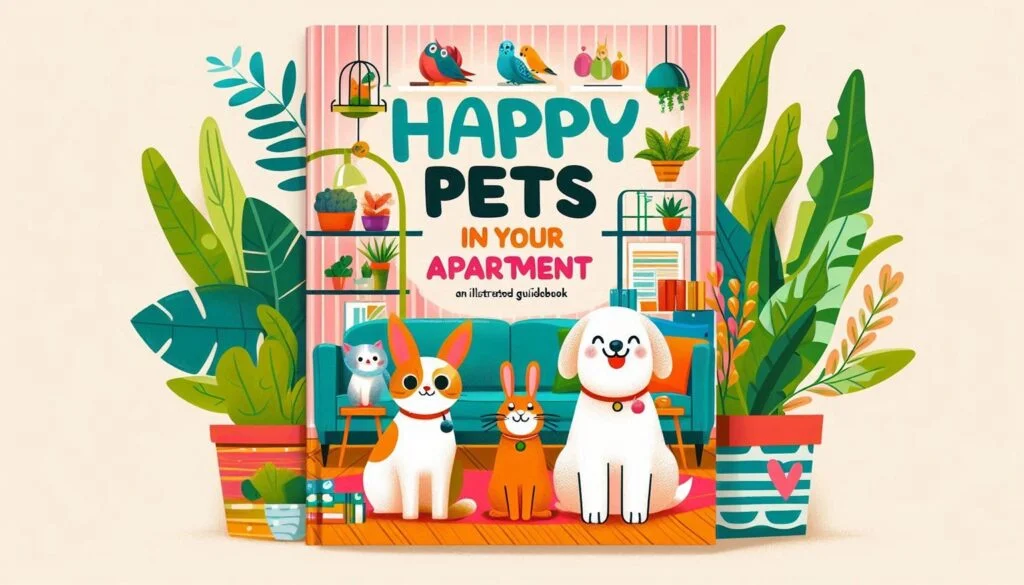Living in an apartment doesn’t have to mean sacrificing the companionship of a furry (or feathery) friend. With a little planning and creativity, you can create a cozy and enriching home for both you and your pet, even in a limited space.
This guide will walk you through everything you need to know about keeping pets in a small apartment, from navigating pet policies to creating a happy and healthy living environment for your pint-sized pal.
Can You Even Have Pets in an Apartment?

Before you start browsing adorable pet pictures online, it’s crucial to understand your apartment’s pet policy.
Here’s what you need to check:
- Checking Your Lease Agreement: This is your first stop. Read your lease agreement thoroughly to see if pets are allowed. If they are, there might be specific restrictions you need to be aware of.
- Understanding Pet Policies: Apartment complexes often have detailed pet policies outlining allowed breeds, weight limits for dogs, and the number of pets permitted per unit. Familiarize yourself with these regulations to avoid any surprises.
- Considering Pet Deposit and Rent Increases: Many apartments require a pet deposit on top of your regular security deposit. There might also be a slight increase in your monthly rent to cover pet-related expenses. Factor these costs into your decision.
Choosing the Perfect Pint-Sized Pal
The key to a successful human-animal cohabitation in a small apartment is choosing the right pet. Here are some factors to consider:
Think Lifestyle:
Do you lead a busy, on-the-go lifestyle, or are you more of a homebody?
High-energy dogs like Border Collies need plenty of exercise, which might be difficult in a small apartment. Consider breeds known for being relatively low-maintenance, such as Shih Tzus or French Bulldogs.
Size Matters:
While giant breeds like Great Danes might be gentle giants, their sheer size simply isn’t ideal for a cramped apartment. Research small dog breeds like Pugs or Yorkshire Terriers that are perfectly content lounging on the couch with you.
Cats are another fantastic option for small spaces, as they’re adept at entertaining themselves and don’t require constant walks.
Gently Does It:
If your schedule doesn’t allow for hours of playtime, consider adopting a low-energy dog breed or a senior pet. These furry friends are often content with shorter walks and cuddles on the couch.
Living in Harmony with Your Pet

Living large in a small space with your furry friend is possible!
This guide offers solutions to common challenges faced by pet parents in apartments, using positive reinforcement and creative space-saving tricks.
Positive Reinforcement Power:
- Barking Blues: Identify the trigger and reward calmness with treats or praise. Gradually introduce triggers at a low level while rewarding quiet behavior.
- Chewing Chaos: Offer a variety of safe chew toys and rotate them for continued interest. When they chew something wrong, offer a firm “no” followed by a “swap” – present a chew toy and praise them for taking it.
- Scratching Mischief: Set your cat up for success! Invest in scratching posts with different textures and heights, placing them near furniture they frequent. Reward them for using the post with praise and treats.
Fresh Space Solutions:
- DIY Deodorizers: Skip harsh chemicals! Fill fabric bags with coffee grounds or dried lavender for natural odor absorption.
- Freeze the Funk: For lingering odors, try the “freeze and freshen” method. Place the item in a sealed bag and freeze it for a few hours. Wash as usual after thawing.
- Plant Powerhouses: Certain pet-safe houseplants like spider plants or peace lilies act as natural air purifiers.
- Cleaning Routines: Vacuum carpets and furniture twice a week. Wash pet bedding and toys regularly. For litter boxes, use clumping litter and scoop waste daily.
Remember, consistency is key!
With patience and these tips, you and your furry friend can thrive in your cozy apartment.
Creating a Pawsome Paradise in Your Tiny Abode
Just because your apartment is small doesn’t mean your pet can’t have a dedicated space.
Here are some tips to maximize your living area and create a haven for your furry (or feathery) companion:
- Utilizing Walls and Shelves for Cat Trees, Perches, and Hiding Spots: Cats are natural climbers. Take advantage of your vertical space by installing cat trees, shelves, and scratching posts along the walls. This provides your feline friend with exercise, entertainment, and a sense of security.
- Multifunctional Furniture: Invest in furniture that does double duty. Ottomans with hidden litter boxes, beds with built-in storage compartments, and collapsible crates can help you save precious floor space.
- Decluttering is Key: Living with a pet in a small apartment means keeping clutter to a minimum. Donate or store unused items to ensure there’s ample space for your pet to play and move around comfortably.
Small apartments might limit your pet’s roaming space, but that doesn’t mean they can’t have a stimulating and enriching life.
Here are some ways to keep your furry friend entertained and mentally engaged:
- Interactive Toys and Puzzle Feeders: Combat boredom with interactive toys that dispense treats or require problem-solving skills. Puzzle feeders are a great way to slow down mealtimes for dogs and stimulate their minds while they work for their kibble.
- Scheduled Walks and Play Sessions: Even indoor pets need regular exercise and playtime. Schedule daily walks for dogs, incorporating sniff breaks and playtime in dog parks if possible. For cats, dedicate time for interactive play sessions with feather wands or laser pointers.
- Creating Catwalks and Play Tunnels: Cats love to climb, explore, and hide. Consider installing catwalks along the walls or purchasing pre-made play tunnels to provide your feline friend with a dedicated play area that doesn’t take up much floor space.
Indoor Activities for Apartment Pets

Living in a small apartment doesn’t mean your pet has to miss out on the fun!
Here are some engaging indoor activities that require minimal space but keep your furry friend mentally and physically stimulated:
1. Scent Work: Tap into your pet’s natural sniffing abilities with scent games. Hide treats or their favorite toy around the apartment and encourage them to use their nose to find it. You can gradually increase the difficulty by hiding the scent in different locations or containers.
- Bonus Tip: For an extra challenge, try using a snuffle mat. These fabric mats with hidden pockets are great for keeping your pet occupied while they sniff out hidden treats.
2. Target Training: Transform everyday objects into training tools! Teach your dog or cat to touch a specific target, like a spoon or a hand signal, for a reward. This is a fun way to bond with your pet and practice basic obedience skills.
- Resources: Websites like Kikopup positive dog training or Clicker training for cats offer free tutorials and resources on positive reinforcement training techniques like target training.
3. Puzzle Feeders: Turn mealtimes into a mental challenge with puzzle feeders. These interactive toys dispense kibble or treats only after your pet figures out how to manipulate them. It keeps them entertained while slowing down their eating habits.
- Apps for Inspiration: Check out apps like “Food Puzzles for Dogs” or “CleverPet” that offer a variety of puzzle feeder challenges and difficulty levels to keep your pet engaged.
4. Indoor Obstacle Courses: Get creative and set up a mini obstacle course using household items! Use pillows as hurdles, boxes as tunnels, and chairs as platforms. Guide your pet through the course with treats or praise, offering them a fun and low-impact workout.
5. Clicker Play: Clicker training is a fantastic way to teach your pet new tricks and strengthen your bond. Use a clicker to mark the desired behavior and reward them with a treat. Clicker play sessions can be short and engaging, making them perfect for small apartment living.
Keep it Fun and Short: Remember, short and frequent play sessions are more effective than long, drawn-out ones. End playtime on a positive note and adjust the difficulty of the activities based on your pet’s age and fitness level.
By incorporating these activities into your pet’s routine, you can keep them entertained and mentally stimulated, even in the confines of your small apartment.
Remember, a happy and engaged pet makes for a happy and harmonious home environment!
Living in Harmony with Your Neighbors
Sharing your living space with fellow apartment dwellers means being a considerate pet owner. Here are some tips for maintaining peace and quiet:
- Proper Pet Training: The foundation of respectful apartment living is proper pet training. Train your dog to minimize barking indoors and on walks. Use positive reinforcement techniques to teach your cat appropriate scratching behaviors to prevent them from damaging furniture or walls.
- Waste Management: Nobody enjoys unpleasant pet odors. For cat owners, regular litter box scooping and cleaning are essential. Dog owners should be responsible pet parents, picking up after their furry companions during walks and disposing of waste properly.
- Being a Considerate Pet Owner: Respect your neighbors by keeping noise levels down, especially during late hours. If your dog barks excessively, consider crate training or working with a trainer to address the issue.
The Wrap Up
Living in a small apartment doesn’t have to be a barrier to pet ownership. With careful planning, the right pet choice, and some creative space-saving solutions, you can create a loving and enriching home for both you and your furry friend. Remember, the joys of pet companionship – the unconditional love, the happy greetings after a long day – are just as fulfilling in a small space.



